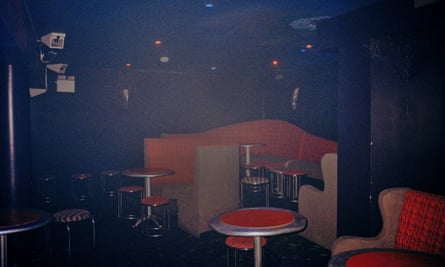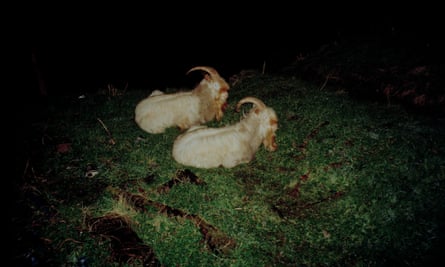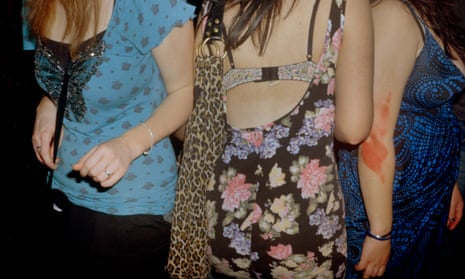There is a strain of recent Irish fiction that deals with the tensions of being young, male and messed-up in small-town Ireland, where jobs are scarce, ambitions are stillborn and getting blocked in bars and clubs every weekend is a recurring, almost parodic, ritual of self-obliteration. Think Kevin Barry’s raucously inventive debut novel City of Bohane, or Colin Barrett’s acclaimed short story collection Young Skins, both of which nod to the small-town surreal brutalism of Pat McCabe’s pivotal novel from 1992, The Butcher Boy.
In many ways, Ciarán Óg Arnold’s photobook – called I Went to the Worst of Bars Hoping to Get Killed. But All I Could Do Was to Get Drunk Again – belongs to that same tradition as much as any photographic lineage.
The work, which has just won the First Book award, was shot in and around his hometown of Ballinasloe in County Galway; it is an almost hallucinatory invocation of that weekend ritual in which he uses the graininess of cheap film as well as high-contrast black-and-white and colour to brilliant effect. “It wasn’t my intention to create a style or an aesthetic, but that grainy look become one as I continued working,” says Arnold. “It’s really down to the fact that I was so broke for most of the time I was shooting these images that I mostly used the 200 ASA Kodak film you are given free when you pick up your snaps from a chemists.” He was just about to give up photography altogether, he says, when he heard that he had been shortlisted for the award by Karen Downey, curator of the Belfast Exposed Gallery. “I don’t even have a website, but I will definitely get on the case now.”

Arnold’s book will be published next month by Mack Books, whose director, Michael Mack, says: “Ciarán Óg Arnold’s project is a heartfelt story of home. The book is a sincere self-portrait where the boundaries between his own state of consciousness and his photography blur into a compelling document of lives tinged with humour and often brutal sadness.”
Arnold certainly has an eye for the ominous and the threatening, and he has created a tense, self-contained world of scabby interiors and ominous exteriors: dimly lit bars, packed clubs and strobe-lit dancefloors, but also the concrete car parks and dark alleyways outside – those liminal spaces fraught with danger as the long night grinds to an often messy close. Groups of lads in sportswear and jeans congregate around the available young women, who, in Arnold’s images, seem distant, almost imperious, amid the myriad rituals of masculinity.
The book’s title comes from the opening line of a poem, The Suicide Kid, by the American author and infamous dissolute Charles Bukowski. It summons up the atmosphere of desperation that Arnold’s images carry as a kind of dark, simmering undertow. Young men grimace, leer, fiercely embrace, face off at the camera or against each others. These scenes are punctuated by brightly coloured closeups of bodies on the dancefloor and stark portraits of individual punters, often looking wrecked, as well as mysterious landscapes in which even the trees swaying in the wind seem ominous.
“The sense of being almost enclosed in this world is, I hope, evident,” he says. “That frustration with nothing changing, yet everything being constantly repeated, gives these places a heightened atmosphere.”
Arnold’s upbringing was middle-class – his father was the local doctor – but he found himself falling into the dead-end life after returning to Ballinasloe when he lost his job in Galway. “I came back to a place that had changed in lots of ways, but was still essentially the same,” he continues. “Like a lot of small towns in Ireland, the financial crash meant that jobs went overnight. It seemed like the whole building trade in Ireland just imploded. After that, people started leaving in droves. There was definitely the sense that almost everyone young had gone save for a few stragglers – and I was one of them. Suddenly, a year turned into two, and then six. And it was: where is my life going? I was caught up in the emptiness and repetition of that life: bar to club to bar, getting wrecked. It’s like you open one door to leave and you’re back in the same room again.”

In 2012, Arnold left Ballinasloe for Belfast, to study for an MFA in photography at the School of Art and Design, a course led by photographer Paul Seawight. “It was Paul and Donovan [Wylie, who also lectures there] who encouraged me to go back to Ballinasloe and keep taking photographs,” says Arnold. He cites Boris Mikhailov, William Eggleston and, above all, Richard Billingham as “photographers I like but I wouldn’t say I was influenced by”.
When I mention Kevin Barry’s writing, though, he acknowledges a creative touchstone. “I love his writing. It’s about a place I recognise. There’s a similar desperation in his stories and that sense of warped masculinity. I think a lot of these guys want intimacy, but they can’t – or don’t know how to – get it. They’ve lost their jobs, or never had one to begin with, and there is a feeling that they are trapped and somehow worthless. At least, I sense that’s what they feel. The masculinity thing is definitely a big part of the work.”
Was he surprised when he heard he had won the First Book award, given the strength of the shortlist? “Surprised is an understatement. I thought my kind of approach was old-fashioned, but evidently not.” Has it changed his plans? “Well, I’m working in finance for my brother’s company at the moment, but I want to make a go of photography. This is a pretty good incentive.”
I Went to the Worst of Bars will be published by Mack Books in May. See more at The Kraszna-Krausz and First Book Awards 2015 display at Media Space, London SW7, until 28 June.
- This article was amended on 21 April 2015 following a complaint.

Comments (…)
Sign in or create your Guardian account to join the discussion